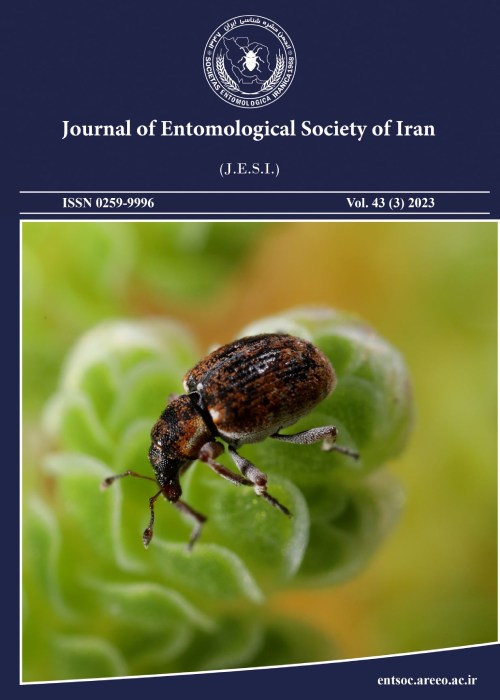First report of thiodicarb resistance of the cotton bollworm, Helicoverpa armigera (Hubner) in Iran
Author(s):
Article Type:
Research/Original Article (دارای رتبه معتبر)
Abstract:
The cotton bollworm, Helicoverpa armigera (Hübner) is one of the most destructive pests in Iran, attacking to a wide range of important crops such as cotton, tomato, soya and corn which causes serious loss of production. Biological characteristics, such as polyphagous nature, migration ability, high rate of reproduction and facultative diapause has caused this pest as one of the potential pest to develop resistant to insecticides. In this research we studied the resistance status of some cotton bollworm populations from Gorgan, Moghan and Varamin against indoxacarb, thiodicarb, profenofos and chlorpyrifos. Topical application of insecticides was used as bioassay method for profenofos and chlorpyrifos and diet-incorporation method for indoxacarb and thiodicarb. The results indicated that Gorgan population has developed high resistance against thiodicarb with resistance factor (RF) of 267 and 262 in 2016 and 2017, respectively. RF against thiodicarb for Moghan was 8.75 and 10.9 in two years, while this value was 3.4 and 6.9 for Varamin. In the case of indoxacarb, RF was less than 10 in all populations, however in Gorgan population increased trend was observed (7.44 in 2016 and 10.34 in 2017). In the case of chlorpyrifos, increased RF (5.13 in 2016 and 10.86 in 2017) was only observed in Moghan population and in other populations, significant change within two years was not observed. The susceptibility of the pest against profenofos was not changed during two years and RF was calculated less than 10 in all populations. As the RF was high against thiodicarb in the Gorgan population, the detoxification enzymes (esterases, glutathione S-transferases and mono-oxygenases) were measured to know if the metabolic resistance was involved. There was no significant difference between resistant and susceptible populations, indicating that other resistance mechanisms (such as target site insensitivity) likely is the cause of the resistance, which must be investigated in further researches.
Keywords:
Language:
Persian
Published:
Journal of Entomological Society of Iran, Volume:39 Issue: 2, 2019
Pages:
195 to 212
magiran.com/p2051131
دانلود و مطالعه متن این مقاله با یکی از روشهای زیر امکان پذیر است:
اشتراک شخصی
با عضویت و پرداخت آنلاین حق اشتراک یکساله به مبلغ 1,390,000ريال میتوانید 70 عنوان مطلب دانلود کنید!
اشتراک سازمانی
به کتابخانه دانشگاه یا محل کار خود پیشنهاد کنید تا اشتراک سازمانی این پایگاه را برای دسترسی نامحدود همه کاربران به متن مطالب تهیه نمایند!
توجه!
- حق عضویت دریافتی صرف حمایت از نشریات عضو و نگهداری، تکمیل و توسعه مگیران میشود.
- پرداخت حق اشتراک و دانلود مقالات اجازه بازنشر آن در سایر رسانههای چاپی و دیجیتال را به کاربر نمیدهد.
دسترسی سراسری کاربران دانشگاه پیام نور!
اعضای هیئت علمی و دانشجویان دانشگاه پیام نور در سراسر کشور، در صورت ثبت نام با ایمیل دانشگاهی، تا پایان فروردین ماه 1403 به مقالات سایت دسترسی خواهند داشت!
In order to view content subscription is required
Personal subscription
Subscribe magiran.com for 70 € euros via PayPal and download 70 articles during a year.
Organization subscription
Please contact us to subscribe your university or library for unlimited access!


